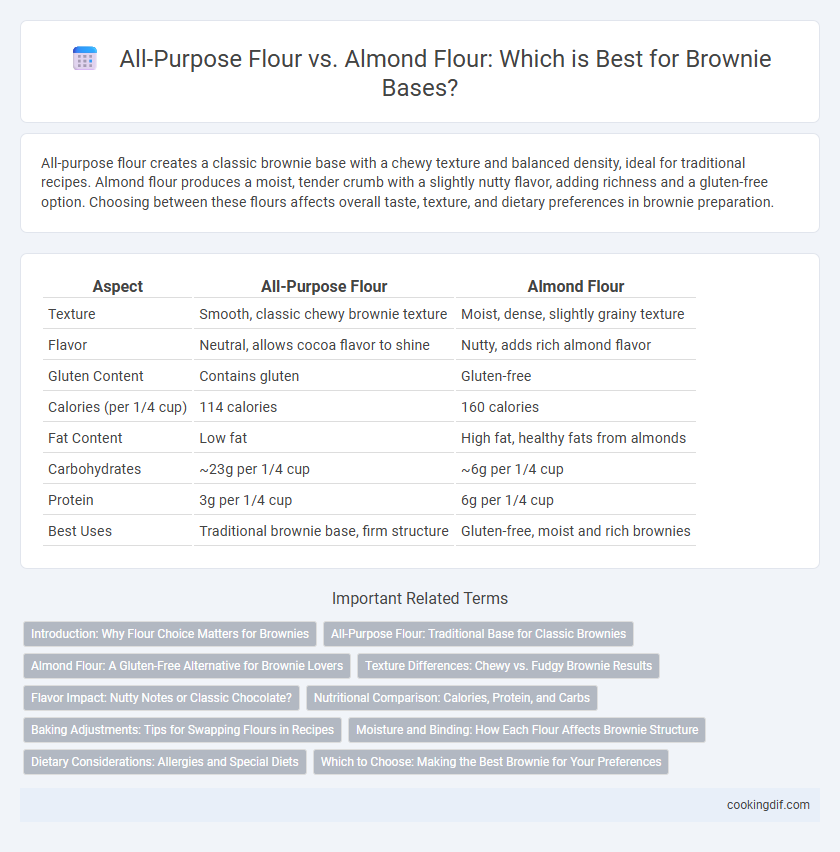All-purpose flour creates a classic brownie base with a chewy texture and balanced density, ideal for traditional recipes. Almond flour produces a moist, tender crumb with a slightly nutty flavor, adding richness and a gluten-free option. Choosing between these flours affects overall taste, texture, and dietary preferences in brownie preparation.
Table of Comparison
| Aspect | All-Purpose Flour | Almond Flour |
|---|---|---|
| Texture | Smooth, classic chewy brownie texture | Moist, dense, slightly grainy texture |
| Flavor | Neutral, allows cocoa flavor to shine | Nutty, adds rich almond flavor |
| Gluten Content | Contains gluten | Gluten-free |
| Calories (per 1/4 cup) | 114 calories | 160 calories |
| Fat Content | Low fat | High fat, healthy fats from almonds |
| Carbohydrates | ~23g per 1/4 cup | ~6g per 1/4 cup |
| Protein | 3g per 1/4 cup | 6g per 1/4 cup |
| Best Uses | Traditional brownie base, firm structure | Gluten-free, moist and rich brownies |
Introduction: Why Flour Choice Matters for Brownies
The choice between all-purpose flour and almond flour significantly impacts brownie texture and flavor, with all-purpose flour providing a classic dense and chewy structure while almond flour offers a moist, tender crumb with a nutty undertone. All-purpose flour's high gluten content develops elasticity and firmness, making it ideal for traditional fudgy brownies, whereas almond flour, gluten-free and low in carbohydrates, lends itself to richer, softer, and more delicate brownies suited for gluten-sensitive diets. Understanding these differences allows bakers to tailor brownies to specific dietary needs and desired textures without compromising flavor quality.
All-Purpose Flour: Traditional Base for Classic Brownies
All-purpose flour provides the ideal structure and texture for classic brownies, delivering a balance of chewiness and softness that defines traditional recipes. Its moderate protein content creates a sturdy yet tender crumb, ensuring the brownies hold their shape while remaining moist. Compared to almond flour, all-purpose flour yields a more consistent rise and density, crucial for achieving the familiar fudgy finish beloved in classic brownies.
Almond Flour: A Gluten-Free Alternative for Brownie Lovers
Almond flour provides a rich, moist texture ideal for brownies while being naturally gluten-free, making it perfect for those with gluten sensitivities. Its higher fat content compared to all-purpose flour results in denser, fudgier brownies with a slightly nutty flavor. Using almond flour also boosts the nutritional profile with added protein, healthy fats, and vitamin E, enhancing the overall indulgence without compromising on taste.
Texture Differences: Chewy vs. Fudgy Brownie Results
All-purpose flour produces brownies with a chewy texture due to its higher gluten content, which creates a denser and more structured crumb. Almond flour, being gluten-free and more moist, results in fudgier brownies that are rich and tender with a slightly grainy mouthfeel. Choosing between these flours depends on whether a traditional chewy bite or a moist, fudgy consistency is desired in the brownie base.
Flavor Impact: Nutty Notes or Classic Chocolate?
All-purpose flour provides a neutral base that lets the classic chocolate flavor of brownies shine with a rich, fudgy texture. Almond flour introduces subtle nutty undertones, enhancing the overall depth and adding a slightly grainy texture that complements the chocolate. Choosing almond flour results in a more complex flavor profile, while all-purpose flour maintains the traditional, indulgent chocolate experience.
Nutritional Comparison: Calories, Protein, and Carbs
All-purpose flour contains approximately 455 calories, 13 grams of protein, and 95 grams of carbohydrates per 100 grams, making it a high-carb option for brownie bases. Almond flour offers around 570 calories, 21 grams of protein, and only 20 grams of carbohydrates per 100 grams, providing a lower-carb and higher-protein alternative. Choosing almond flour can enhance the nutritional profile of brownies by increasing protein content while significantly reducing carbs.
Baking Adjustments: Tips for Swapping Flours in Recipes
When swapping all-purpose flour with almond flour for a brownie base, reduce the amount by about 25% due to almond flour's higher fat content and moisture level. Incorporate additional binding agents such as eggs or flaxseed meal to compensate for almond flour's lack of gluten, which is crucial for structure. Adjust baking time by lowering oven temperature by 25degF and checking for doneness earlier to prevent overbaking.
Moisture and Binding: How Each Flour Affects Brownie Structure
All-purpose flour provides a higher gluten content, which enhances the binding and structure of brownies, resulting in a denser, chewier texture. Almond flour contains more moisture and fat, contributing to a softer, moister brownie but with a looser crumb and less structural integrity. The choice between these flours greatly influences the brownie's moisture retention and overall firmness.
Dietary Considerations: Allergies and Special Diets
All-purpose flour contains gluten, making it unsuitable for individuals with celiac disease or gluten intolerance, whereas almond flour is naturally gluten-free and ideal for low-carb or paleo diets. Almond flour provides higher protein, fiber, and healthy fats, benefiting those requiring blood sugar control or heart-healthy alternatives. People with nut allergies must avoid almond flour, making all-purpose flour the safer choice unless a specialized gluten-free option is needed.
Which to Choose: Making the Best Brownie for Your Preferences
All-purpose flour delivers a classic, chewy brownie texture with balanced moisture and structure, ideal for traditional recipes and those preferring a familiar taste. Almond flour produces denser, fudgier brownies rich in healthy fats and a subtle nutty flavor, suited for gluten-free diets and enhanced nutritional content. Choosing between all-purpose and almond flour depends on dietary needs and desired brownie texture, with almond flour offering a moist, grainier crumb and all-purpose ensuring a tender, cakey bite.
All-purpose flour vs almond flour for brownie base Infographic

 cookingdif.com
cookingdif.com